初中英语五种时态
- 格式:ppt
- 大小:89.54 KB
- 文档页数:32
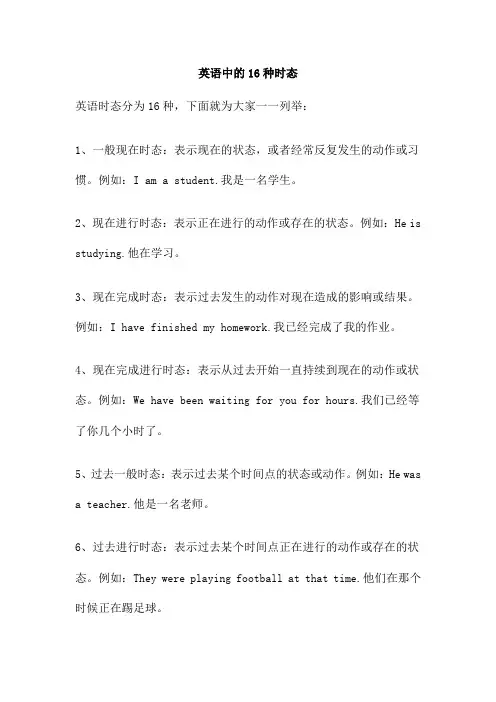
英语中的16种时态英语时态分为16种,下面就为大家一一列举:1、一般现在时态:表示现在的状态,或者经常反复发生的动作或习惯。
例如:I am a student.我是一名学生。
2、现在进行时态:表示正在进行的动作或存在的状态。
例如:He is studying.他在学习。
3、现在完成时态:表示过去发生的动作对现在造成的影响或结果。
例如:I have finished my homework.我已经完成了我的作业。
4、现在完成进行时态:表示从过去开始一直持续到现在的动作或状态。
例如:We have been waiting for you for hours.我们已经等了你几个小时了。
5、过去一般时态:表示过去某个时间点的状态或动作。
例如:He wasa teacher.他是一名老师。
6、过去进行时态:表示过去某个时间点正在进行的动作或存在的状态。
例如:They were playing football at that time.他们在那个时候正在踢足球。
7、过去完成时态:表示过去的过去,即过去某一时间之前发生的动作或状态。
例如:They had finished their work before we arrived.在我们到达之前,他们已经完成了他们的工作。
8、过去完成进行时态:表示过去某一时间之前一直在进行的动作或状态。
例如:We had been waiting for the bus for hours before it finally arrived.在公共汽车最终到达之前,我们已经等了好几个小时。
9、将来一般时态:表示将来某个时间点的状态或动作。
例如:She will be a doctor.她将成为一名医生。
10、将来进行时态:表示将来某个时间点正在进行的动作或存在的状态。
例如:We will be studying in the library tomorrow afternoon.我们明天下午将在图书馆学习。
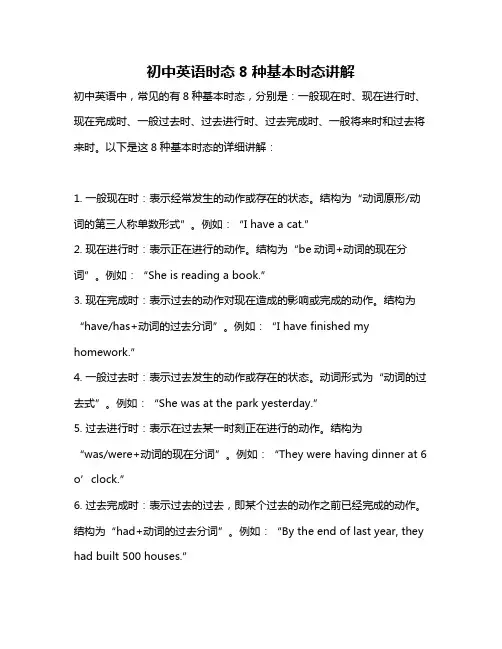
初中英语时态8种基本时态讲解初中英语中,常见的有8种基本时态,分别是:一般现在时、现在进行时、现在完成时、一般过去时、过去进行时、过去完成时、一般将来时和过去将来时。
以下是这8种基本时态的详细讲解:1. 一般现在时:表示经常发生的动作或存在的状态。
结构为“动词原形/动词的第三人称单数形式”。
例如:“I have a cat.”2. 现在进行时:表示正在进行的动作。
结构为“be动词+动词的现在分词”。
例如:“She is reading a book.”3. 现在完成时:表示过去的动作对现在造成的影响或完成的动作。
结构为“have/has+动词的过去分词”。
例如:“I have finished my homework.”4. 一般过去时:表示过去发生的动作或存在的状态。
动词形式为“动词的过去式”。
例如:“She was at the park yesterday.”5. 过去进行时:表示在过去某一时刻正在进行的动作。
结构为“was/were+动词的现在分词”。
例如:“They were having dinner at 6 o’clock.”6. 过去完成时:表示过去的过去,即某个过去的动作之前已经完成的动作。
结构为“had+动词的过去分词”。
例如:“By the end of last year, they had built 500 houses.”7. 一般将来时:表示将来要发生的动作或存在的状态。
结构为“will+动词原形”或“am/is/are going to+动词原形”。
例如:“We will visit the museum next week.”8. 过去将来时:表示从过去的某一时刻看,将来要发生的动作或存在的状态。
结构为“would+动词原形”或“was/were going to+动词原形”。
例如:“He said he would come back soon.”以上就是初中英语8种基本时态的讲解,希望对你有帮助!。
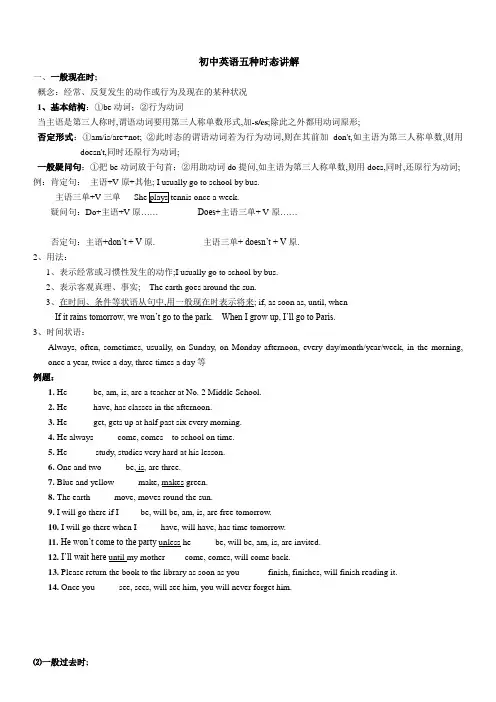
初中英语五种时态讲解一、一般现在时;概念:经常、反复发生的动作或行为及现在的某种状况1、基本结构:①be动词;②行为动词当主语是第三人称时,谓语动词要用第三人称单数形式,加-s/es;除此之外都用动词原形;否定形式:①am/is/are+not; ②此时态的谓语动词若为行为动词,则在其前加don't,如主语为第三人称单数,则用doesn't,同时还原行为动词;一般疑问句:①把be动词放于句首;②用助动词do提问,如主语为第三人称单数,则用does,同时,还原行为动词; 例:肯定句:主语+V原+其他; I usually go to school by bus.主语三单+V三单疑问句:Do+主语+V原…… Does+主语三单+ V原……否定句:主语+don’t + V原. 主语三单+ doesn’t + V原.2、用法:1、表示经常或习惯性发生的动作;I usually go to school by bus.2、表示客观真理、事实; The earth goes around the sun.3、在时间、条件等状语从句中,用一般现在时表示将来; if, as soon as, until, whenIf it rains tomorrow, we won’t go to the park. When I grow up, I’ll go to Paris.3、时间状语:Always, often, sometimes, usually, on Sunday, on Monday afternoon, every day/month/year/week, in the morning, once a year, twice a day, three times a day等例题:1. He______be, am, is, are a teacher at No. 2 Middle School.2. He______have, has classes in the afternoon.3. He______get, gets up at half past six every morning.4. He always _____come, comes to school on time.5. He ______study, studies very hard at his lesson.6. One and two _____be, is, are three.7. Blue and yellow _____make, makes green.8. The earth _____move, moves round the sun.9. I will go there if I ____ be, will be, am, is, are free tomorrow.10. I will go there when I _____have, will have, has time tomorrow.11. He won’t come to the party unless he _____be, will be, am, is, are invited.12. I’ll wait here until my mother ____come, comes, will come back.13. Please return the book to the library as soon as you ______finish, finishes, will finish reading it.14. Once you _____see, sees, will see him, you will never forget him.⑵一般过去时;1、⑴表示过去某个时间发生的动作或存在的状态; I got up late this morning.⑵表示过去的习惯或经常发生的动作;When I was in the countryside. I often swam in the river. I used to go fishing.2、结构:基本结构:①be动词;②行为动词否定形式:①was/were+not; ②在行为动词前加didn't,同时还原行为动词;一般疑问句:①was或were放于句首;②用助动词do的过去式did 提问,同时还原行为动词;例:肯定句:主语+ V过去+其他;疑问句:Did+主语+ V原……否定句:主语+didn’t+ V原3、动词的规则变化;4、时间状语:Yesterday, last night/week/year/month, last Sunday, in 1995, the other day, just now, ago等例题:1. He____be, was, were, been here a moment ago.2. They ____be, was, were, been here just now.3. The scientists _____leave, leaves, leaved, left for America yesterday.4. Last week we ______visit, visited the Science Museum.5. When I was a child, I often ____play, played football.6. The students ran out of the classroom as soon as the bell ____ring, rang, rung.⑶一般将来时;①肯定句:否定句:注:当主语为I 或we时,问句中可用shall where shall we meet tomorrow②be going to+ V原表示计划、打算做某事;用来表示近期或事先考虑过的将要发生的动作以及已有迹象表明必将发生某事,意为“打算;就要”; be going to do 将要干某事---what are you going to do next Sunday ---I am going to listen to music.Look at the clouds, there is going to rain.③现在进行时be +Ving 有时可以表示将来;常用这种结构的动词:go, come, leave, stay, start, arrive We’re leaving for London.例题:1 . _____you ____a doctor when you grow upA .Will; going to be B. Are; going to be C. Are; / D .Will; be2. I don’t know if his uncle _____. I think he _____ if it doesn’t rain.A will come; comesB will come; will comeC comes; comesD comes; will come3 . He will be back _____a few minutes.A withB forC onD in4. What time _____we meet at the gate tomorrowA willB shallC doD are5. He will have a holiday as soon as he _____the work next week.A finishes B. doesn’t finish C will finish D won’t finish6 .There _____some showers this afternoon.A will beB will haveC is going to beD are going to have7. It ____my brother’s birthday tomorrow. She _____a party.A is going to be; will haveB will be; is havingC will be; is going to haveD will have; is going to be8. Li Ming is 10 years old now, next year he _____11.A isB is going to beC will beD will to be与will区别:两者都可表示将要发生的事、将要去做某事,但它们有如下几点区别:1. 表示近期、眼下就要发生的事情,will 表示的将来时间则较远一些,如:He is going to write a letter tonight.He will write a book .2. 表示根据主观判断将来肯定发生的事情,will表示客观上将来势必发生的事情;He is seriously ill. He is going to die.He will be twenty years old.3. be going to 含有“计划,准备”的意思,而will 则没有这个意思,如:She is going to lend us her book.He will be here in half an hour.4.在有的主句中,一般不用be going to, 而多用will, 如:If any beasts comes at you, I'll stay with you and help you4现在进行时1、构成:肯定句:主语+ is / am / are +ving疑问句:Is /Am /Are + 主语+ving否定句:主语+ isn’t / am not / aren’t + ving2、用法:①表示正在进行的动作I’m reading book now.②表示现阶段正在进行的动作或状态; They are studying hard this term.3、时间状语:now , these days, 当句中有look, listen , can’t you see, can you see时Listen He is singing.例题:1. I ____write, am writing, is writing, are writing a letter now.2. Look, it _____begin, is beginning, am beginning, are beginning to rain.3. They ____study, is studying, am studying, are studying medicine at the Medical Institute of Chengde these days.4. He _____teach, am teaching, is teaching, are teaching an English lesson at this time.5 过去进行时1、结构was / were + doing2、用法①表示过去某段时间正在进行的动作---what were you doing at 9:30 last night --- I was watching TV.3、when一般接一般过去时I was doing my homework whenwhile一般接进行时WhileHe was playing basketball while she was reading books.例题:1. I _____cook, cooked, was cooking, were cooking breakfast when you arrived.____you_____ do, did, was...doing, were…doing at this time yesterday eveninghave, are having, had, were having dinner when the doorbell rang.When/ As we____ have, had, are having, were having dinner, the doorbell rang.动词基本变化形式:。
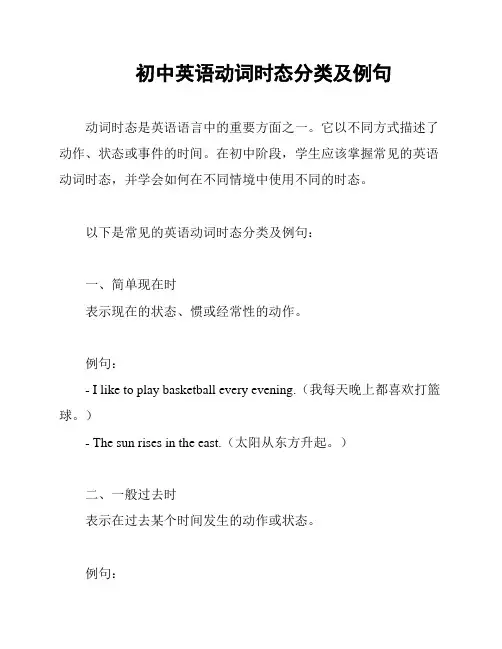
初中英语动词时态分类及例句动词时态是英语语言中的重要方面之一。
它以不同方式描述了动作、状态或事件的时间。
在初中阶段,学生应该掌握常见的英语动词时态,并学会如何在不同情境中使用不同的时态。
以下是常见的英语动词时态分类及例句:一、简单现在时表示现在的状态、惯或经常性的动作。
例句:- I like to play basketball every evening.(我每天晚上都喜欢打篮球。
)- The sun rises in the east.(太阳从东方升起。
)二、一般过去时表示在过去某个时间发生的动作或状态。
例句:- He walked to school yesterday.(昨天他步行去学校了。
)- I visited my grandparents last summer.(我去年夏天拜访了我的祖父母。
)三、现在进行时表示现在正在进行的动作。
例句:- They are watching a movie now.(他们现在正在看电影。
)- She is studying in the library at the moment.(她现在正在图书馆研究。
)四、过去进行时表示过去某个时间正在进行的动作。
例句:- She was teaching in the classroom at 2 pm yesterday.(昨天下午2点她正在教室里上课。
)- I was studying when he called me.(他给我打电话的时候我正在研究。
)五、将来时表示将要发生的动作或状态。
例句:- They will go to Beijing next week.(他们下周将去北京。
)- I am sure she will like the present.(我确信她会喜欢这个礼物。
)六、过去完成时表示过去某个时间之前已经完成的动作。
例句:- She had finished her work by 5 pm.(下午5点她已经完成了她的工作。
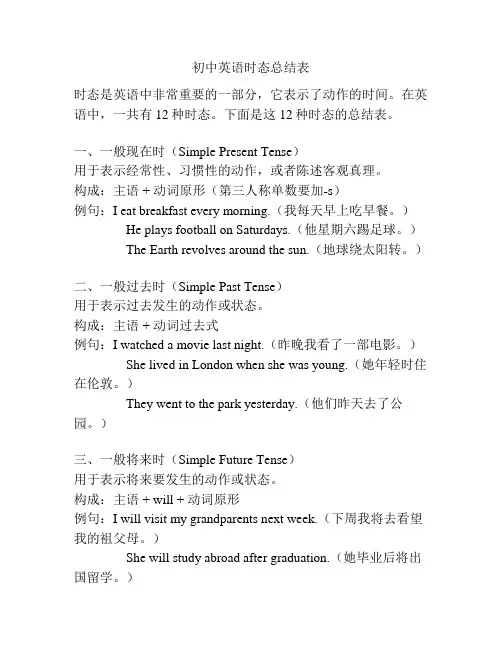
初中英语时态总结表时态是英语中非常重要的一部分,它表示了动作的时间。
在英语中,一共有12种时态。
下面是这12种时态的总结表。
一、一般现在时(Simple Present Tense)用于表示经常性、习惯性的动作,或者陈述客观真理。
构成:主语 + 动词原形(第三人称单数要加-s)例句:I eat breakfast every morning.(我每天早上吃早餐。
)He plays football on Saturdays.(他星期六踢足球。
)The Earth revolves around the sun.(地球绕太阳转。
)二、一般过去时(Simple Past Tense)用于表示过去发生的动作或状态。
构成:主语 + 动词过去式例句:I watched a movie last night.(昨晚我看了一部电影。
)She lived in London when she was young.(她年轻时住在伦敦。
)They went to the park yesterday.(他们昨天去了公园。
)三、一般将来时(Simple Future Tense)用于表示将来要发生的动作或状态。
构成:主语 + will + 动词原形例句:I will visit my grandparents next week.(下周我将去看望我的祖父母。
)She will study abroad after graduation.(她毕业后将出国留学。
)They will have a party on Friday.(他们将在星期五举行一个派对。
)四、现在进行时(Present Continuous Tense)用于表示现在正在进行的动作。
构成:主语 + am/is/are + 现在分词(-ing形式)例句:I am reading a book now.(我现在在读一本书。
)She is playing the piano at the moment.(她此刻正在弹钢琴。
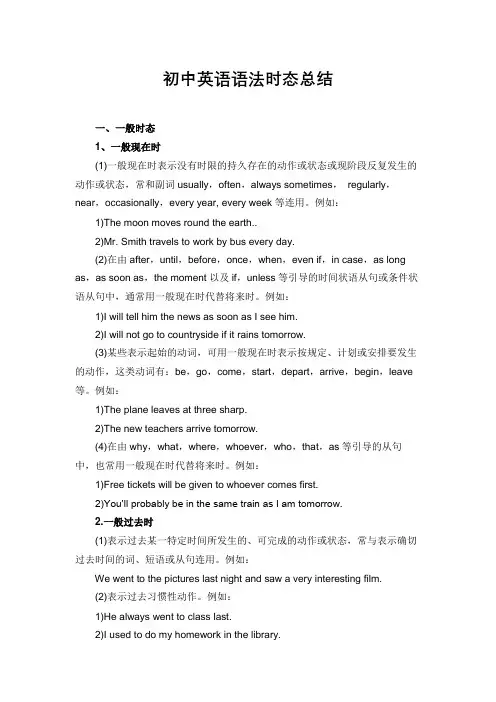
初中英语语法时态总结一、一般时态1、一般现在时(1)一般现在时表示没有时限的持久存在的动作或状态或现阶段反复发生的动作或状态,常和副词usually,often,always sometimes,regularly,near,occasionally,every year, every week等连用。
例如:1)The moon moves round the earth..2)Mr. Smith travels to work by bus every day.(2)在由after,until,before,once,when,even if,in case,as long as,as soon as,the moment以及if,unless等引导的时间状语从句或条件状语从句中,通常用一般现在时代替将来时。
例如:1)I will tell him the news as soon as I see him.2)I will not go to countryside if it rains tomorrow.(3)某些表示起始的动词,可用一般现在时表示按规定、计划或安排要发生的动作,这类动词有:be,go,come,start,depart,arrive,begin,leave 等。
例如:1)The plane leaves at three sharp.2)The new teachers arrive tomorrow.(4)在由why,what,where,whoever,who,that,as等引导的从句中,也常用一般现在时代替将来时。
例如:1)Free tickets will be given to whoever comes first.2)You’ll probably be in the same train as I am tomorrow.2.一般过去时(1)表示过去某一特定时间所发生的、可完成的动作或状态,常与表示确切过去时间的词、短语或从句连用。
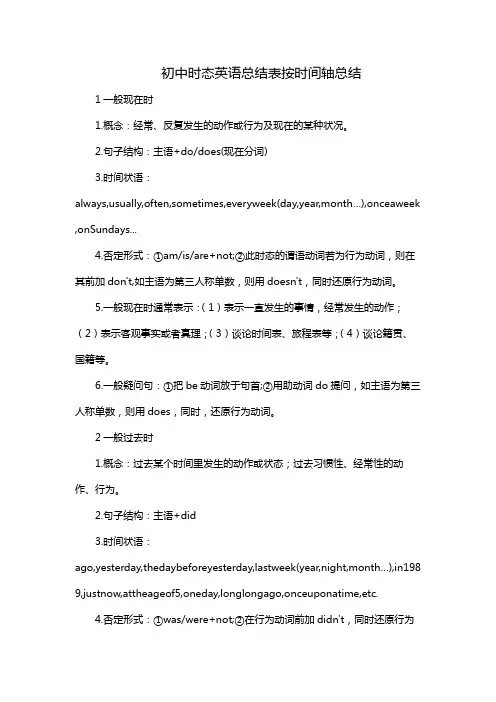
初中时态英语总结表按时间轴总结1一般现在时1.概念:经常、反复发生的动作或行为及现在的某种状况。
2.句子结构:主语+do/does(现在分词)3.时间状语:always,usually,often,sometimes,everyweek(day,year,month…),onceaweek ,onSundays...4.否定形式:①am/is/are+not;②此时态的谓语动词若为行为动词,则在其前加don't,如主语为第三人称单数,则用doesn't,同时还原行为动词。
5.一般现在时通常表示:(1)表示一直发生的事情,经常发生的动作;(2)表示客观事实或者真理;(3)谈论时间表、旅程表等;(4)谈论籍贯、国籍等。
6.一般疑问句:①把be动词放于句首;②用助动词do提问,如主语为第三人称单数,则用does,同时,还原行为动词。
2一般过去时1.概念:过去某个时间里发生的动作或状态;过去习惯性、经常性的动作、行为。
2.句子结构:主语+did3.时间状语:ago,yesterday,thedaybeforeyesterday,lastweek(year,night,month…),in198 9,justnow,attheageof5,oneday,longlongago,onceuponatime,etc.4.否定形式:①was/were+not;②在行为动词前加didn't,同时还原行为动词。
5.一般疑问句:①was或were放于句首;②用助动词do的过去式did提问,同时还原行为动词。
3现在完成时1.概念:过去发生或已经完成的动作对现在造成的影响或结果,或从过去已经开始,持续到现在的动作或状态。
2.句子结构:have/has+done3.时间状语:recently,lately,since…for…,inthepastfewyears,etc.4.否定形式:have/has+not+done.5.一般疑问句:have或has。
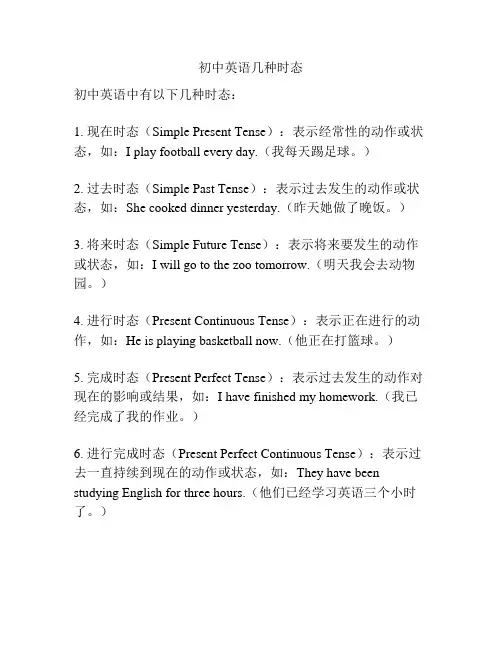
初中英语几种时态
初中英语中有以下几种时态:
1. 现在时态(Simple Present Tense):表示经常性的动作或状态,如:I play football every day.(我每天踢足球。
)
2. 过去时态(Simple Past Tense):表示过去发生的动作或状态,如:She cooked dinner yesterday.(昨天她做了晚饭。
)
3. 将来时态(Simple Future Tense):表示将来要发生的动作或状态,如:I will go to the zoo tomorrow.(明天我会去动物园。
)
4. 进行时态(Present Continuous Tense):表示正在进行的动作,如:He is playing basketball now.(他正在打篮球。
)
5. 完成时态(Present Perfect Tense):表示过去发生的动作对现在的影响或结果,如:I have finished my homework.(我已经完成了我的作业。
)
6. 进行完成时态(Present Perfect Continuous Tense):表示过去一直持续到现在的动作或状态,如:They have been studying English for three hours.(他们已经学习英语三个小时了。
)。
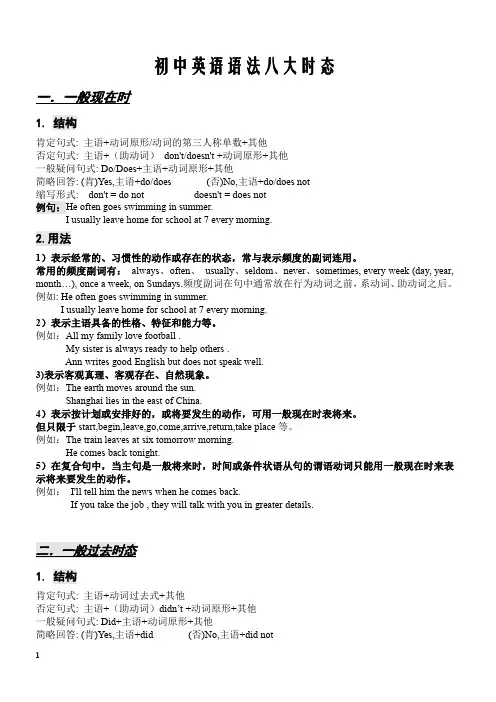
初中英语语法八大时态一.一般现在时1.结构肯定句式:主语+动词原形/动词的第三人称单数+其他否定句式:主语+(助动词)don't/doesn't+动词原形+其他一般疑问句式:Do/Does+主语+动词原形+其他简略回答:(肯)Yes,主语+do/does(否)No,主语+do/does not缩写形式:don't=do not doesn't=does not例句:He often goes swimming in summer.I usually leave home for school at7every morning.2.用法1)表示经常的、习惯性的动作或存在的状态,常与表示频度的副词连用。
常用的频度副词有:always、often、usually、seldom、never、sometimes,every week(day,year, month…),once a week,on Sundays.频度副词在句中通常放在行为动词之前,系动词、助动词之后。
例如:He often goes swimming in summer.I usually leave home for school at7every morning.2)表示主语具备的性格、特征和能力等。
例如:All my family love football.My sister is always ready to help others.Ann writes good English but does not speak well.3)表示客观真理、客观存在、自然现象。
例如:The earth moves around the sun.Shanghai lies in the east of China.4)表示按计划或安排好的,或将要发生的动作,可用一般现在时表将来。
但只限于start,begin,leave,go,come,arrive,return,take place等。
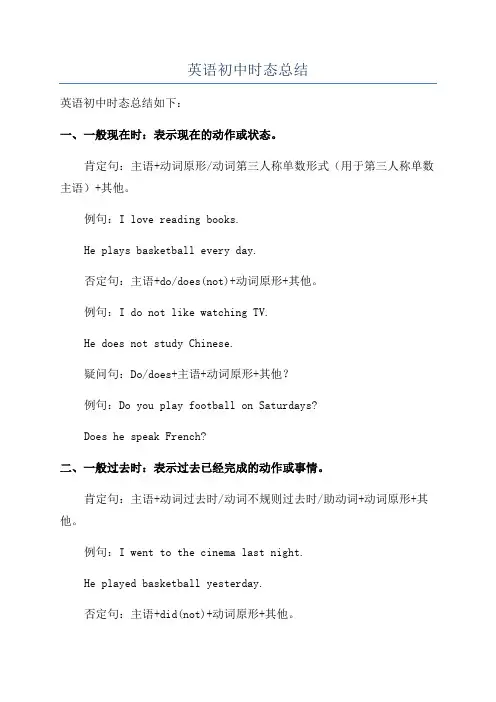
英语初中时态总结英语初中时态总结如下:一、一般现在时:表示现在的动作或状态。
肯定句:主语+动词原形/动词第三人称单数形式(用于第三人称单数主语)+其他。
例句:I love reading books.He plays basketball every day.否定句:主语+do/does(not)+动词原形+其他。
例句:I do not like watching TV.He does not study Chinese.疑问句:Do/does+主语+动词原形+其他?例句:Do you play football on Saturdays?Does he speak French?二、一般过去时:表示过去已经完成的动作或事情。
肯定句:主语+动词过去时/动词不规则过去时/助动词+动词原形+其他。
例句:I went to the cinema last night.He played basketball yesterday.否定句:主语+did(not)+动词原形+其他。
例句:I did not like the movie.He did not watch TV last night.疑问句:Did+主语+动词原形+其他?例句:Did you go to the party last night?Did he play basketball yesterday?三、现在进行时:表示现在正在进行或进行的动作。
肯定句:主语+be(am/is/are)+动词现在分词+其他。
例句:I am reading a book.He is playing basketball.否定句:主语+be(am/is/are(not))+动词现在分词+其他。
例句:I am not watching TV.He is not studying Chinese.疑问句:Be(am/is/are)+主语+动词现在分词+其他?例句:Are you playing football?Is he speaking French?四、过去进行时:表示过去一段时间内正在进行的动作。
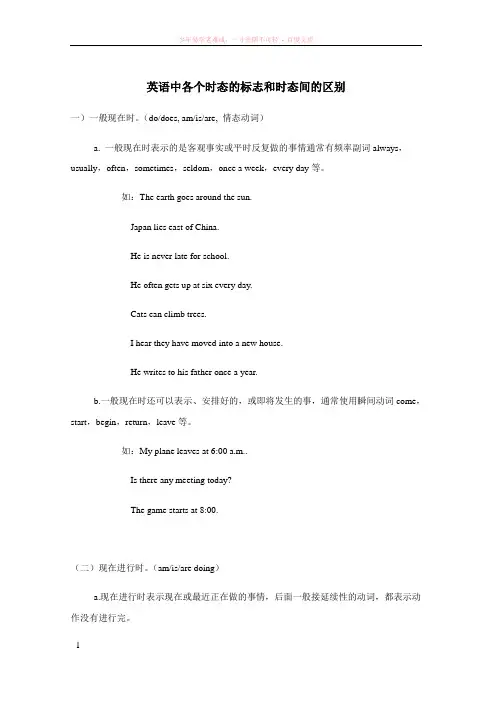
英语中各个时态的标志和时态间的区别一)一般现在时。
(do/does, am/is/are, 情态动词)a. 一般现在时表示的是客观事实或平时反复做的事情通常有频率副词always,usually,often,sometimes,seldom,once a week,every day等。
如:The earth goes around the sun.Japan lies east of China.He is never late for school.He often gets up at six every day.Cats can climb trees.I hear they have moved into a new house.He writes to his father once a year.b.一般现在时还可以表示、安排好的,或即将发生的事,通常使用瞬间动词come,start,begin,return,leave等。
如:My plane leaves at 6:00 a.m..Is there any meeting today?The game starts at 8:00.(二)现在进行时。
(am/is/are doing)a.现在进行时表示现在或最近正在做的事情,后面一般接延续性的动词,都表示动作没有进行完。
如:Look! The boy is dancing.He is watching a football game.What are you doing now?They are preparing for the exam recently.b.还常与always,usually,constantly,forever,continually等词连用表示一种语气,“总是,老是…”,如:He is always working late.Why are you always making this kind of mistake?He is continually getting into trouble with the police.c.后面接暂转动词时表示正在反复的动作,或表示将来时(一般只有go, come, leave 和have)如:The monkeys are jumping.They are hitting the tree.表将来:We are going swimming this afternoon.They are leaving here.They are having an English class tomorrow.试比较:He is doing his homework until his parents come to take him home.He will do his homework until his parents come to take him home.注:表示知觉、感觉、看法、认识、情感或愿望的动词和大部分暂转动词不能用现在进行时。
初中英语的动词时态主要有五种:一般现在时,一般过去时,一般将来时,现在进行时,现在完成时.1. 一般现时的用法:主要由动词原形表示,但在第三人称单数时要在词尾加-s 。
否定句和疑问句要用助动词do, does.A. 经常性或习惯性的动作。
如The trees get green in spring . 。
B现在特征或状态。
如The Changjiang River is the longest in our country.He doesn` t work in the factory .C.普遍真理。
如The sun rises in the east . Five and two in seven .2现在进行时:现在进行时是由助动词be 的人称形式加现在分词构成。
主要表示现在或现阶段正在进行的动作。
如:Where are they swimming? They are swimming in the river.有些动词的现在进行时表示近期按计划或安排要进行的动作。
这些动词是:go ,come, leave ,start ,arrive , return ,work sleep,stay,play,do,have ,wear…..She is coming to see me tomorrow.3.一般将来时:主要表示将要发生的动作或情况。
由助动词shall 或will加动词原形构成。
/ be going to 加动词原形构成It won’t rain tonight .I shall meet you at the station.He is going to have a swim tomorrow.4.一般过去时:由动词的过去式表示。
表示在过去某个时刻发生的动作或情况。
包括过去习惯性动作。
如;Did you knock at the door just now? / He finished reading the book yesterday.5.现在完成时:由have的人称形式加过去分词构成A 到现在为止已经完成的动作。
初中英语六大时态一.一般现在时二.一般过去时三.一般将来时四.现在进行时五.过去进行时六.现在完成时一、一般现在时1.表示现阶段经常性、习惯性的动作或存在的状态,特征;常用时间状语:always (总是) usually (常常) often (经常) sometimes (有时) seldom (很少,少到可忽略不计) never (从不) every day (每天)/week (每周),等「注:seldom 与never 都是否定用法」例句:I always go to school by bus in order to get to the class on time.为了准时去上课,我总是坐公交车上学 He seldom does his homework which make his teacher so mad.他几乎不做作业,这让他的老师非常恼火(※注:主语为第三人称时动词的变化 go →goes )2.在时间状语和条件状语从句中,用一般现在时表将来例句:If you don ’t harry up,you will be late !time 2 1 3如果你不快一点就要迟到啦!You mustn’t eat any thing until you go to hospital.你不能吃任何东西直到你去看医生后「※注:其实就是“主将从现”」3.表示客观真理和事实的时候用一般现在时例句:The sun rises in the east.太阳从东边升起The earth moved around the sun.地球围着太阳转4.begin、come、go、leave、start、arrive等动词常用一般现在时表示按规定按计划将要发生的动作例句:Class begins at 8 in the morning.8点开始上课二、一般过去时1.一般过去时表示过去某时间发生的动作、存在的状态或过去反复发生的动作。
初中英语必须掌握的8大时态英语八大时态:一. 一般现在时标志:动词原形1. 表示经常性或习惯性动作,常与表频度的时间状语连用:She often speaks English.I leave home for school at 7 every morning.2. 表示现在的状态、特征、职业、能力、感觉等:He seems to feel a bit down today.He works as a driver.3. 表示真理、客观存在、科学事实或用于格言警句中:Shanghai lies in the east of China.Columbus proved that the earth is round.Where there is a will, there is a way.4. 表示现在瞬间的动作:Here comes the bus!5. 表示将来1) 表按规定、计划、安排将要发生的动作(仅限于某些表示“来、去、动、停、开始、结束、继续”等的趋向动词),可以与表示未来的时间状语搭配使用。
常见的用法是:飞机、火车、轮船、汽车等定期定点运行的交通状况。
如:The next train leaves at 3 o’clock this afternoon.How often does the shuttle bus run?2) 在时间和条件状语从句中常使用一般现在时表示将来发生的事情:When Bill comes (不用will come), ask him to wait for me.I shall go there tomorrow unless I’m too bus y.二. 一般过去时标志:动词过去式*闭音节:元音字母a, e, i, o, u如果发字母本来的音则称为开音节,否则称为闭音节。
1. 表示过去某时所发生的动作或存在的状态,常与表示过去的时间状语连用(e.g. yesterday, this morning, just now, a moment ago, in May, last night/year / week, once upon a time, the other day, before …,when …, in the past等)。
初中英语所有时态1.一般现在时(do/does; is/am/are)①表示现在的情况、状态或特征。
例:He is a student.他是一个学生。
②表示经常性、习惯性动作。
例:He always helps others.他总是帮助别人。
③客观事实和普遍真理。
例:The earth moves the sun.地球绕着太阳转。
④表示一个按规定、计划或安排要发生的动作。
仅限于某些表示“来、去、动、停、开始、结束、继续”等的动词,可以与表示未来时间的状语搭配使用。
常见的用法是:飞机、火车、轮船、汽车等定期定点运行的交通方式。
例:The next train leaves at 3 o'clock this afternoon.下一趟火车今天下午3点开车。
⑤在时间、条件和让步状语从句中经常用一般现在(有时也用现在完成时)表示将的来事情。
(即:主将从现原则)例:I will call you as soon as I arrive at the airport.我一到机场就会给你打电话。
When you have finished the report, I will have waited for about 3 hours.等你完成这份报告的时候,我就已经等了将近3个小时了。
2. 现在进行时(am/is/are doing)①表示此时此刻正在发生的事情。
例:He is listning to the music now.他现在正在听音乐。
②表示目前一段时间内一直在做的事情,但不一定此时此刻正在做。
例:I am studying computer this term.这个学期我一直在学习计算机。
③现在进行时可以表示将来的含义。
瞬时动词的进行一定表将来。
例:I am leaving.我要离开了。
持续动词的进行只有有将来的时间状语或有将来语境中才表将来。
例:I am travelling next month.下个月我要去旅行。
初中英语的八大时态结构英语中八种基本时态有:一般现在时、一般过去时、现在进行时、过去进行时、现在完成时、过去完成时、—般将来时、过去将来时。
一、一般现在时基本结构:1)动词+原形(如主语为第三人称单数,谓语动词上要加s,es,或变y为i,再加es)2)如果含有be动词:主语+is/am/are+形容词/名词/介词短语等(主语为第三人称单数用is,主语为I用am,主语为复数用are)例句:Our teachers always arrive early.I am an English teacher.二、一般过去时基本结构:1)主语+动词过去式2)如果含有be动词:主语+was/were+形容词/名词/介词短语等(主语为单数用was,主语为复数用are)例句:She sang a song in class yesterday.They were here just now.三、现在进行时基本结构:am/is/are+doing(主语为I用am,主语为第三人称单数用is,主语为复数用are)例句:It's getting colder and colder.They are doing well in their lessons.四、过去进行时基本结构:was/were + doing例句:She was working at nine o'clock yesterday?When I arrived, they were reading a story.五、现在完成时基本结构:has/have + done(过去分词)(主语为单数用has,主语为复数用have)例句:It has rained recently.They have lived here for more than twenty years.六、过去完成时基本结构:had + done(过去分词)例句:By the end of last week,they had reviewed four books.He had bought the car before 2003.七、一般将来时基本结构:1)is/am/are + going to + do(主语为第三人称单数用is,主语为I用am,主语为复数用are)2) shall/will + do(主语为第一人称可用shall/will,其他人称用will)例句:We are going to visit the factory tomorrow.I think she will be back next week.八、过去将来时基本结构:1)was/were + going to + do(主语为单数用was,主语为复数用were)2)would + do例句:They told me they would go to Beijing.The doctor asked who was going there.。